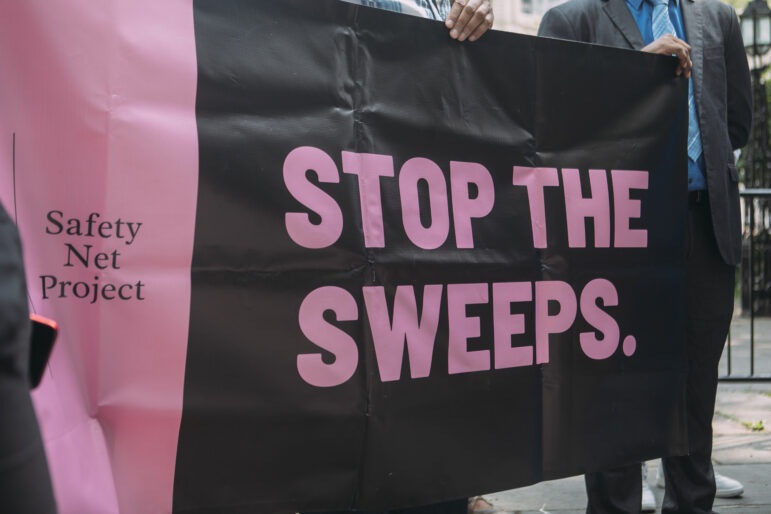The Adams administration will have to report quarterly on the cost and characteristics of “removals,” when city agencies force a person out of a public spot, often clearing their possessions as well.

New Yorkers will soon be able to review data on how frequently Mayor Eric Adams is clearing unhoused people from sight—and at what cost.
The New York City Council on Wednesday passed legislation, sponsored by Brooklyn Councilmembers Sandy Nurse and Shahana Hanif, requiring the Adams administration to report regularly on the cost and characteristics of “removals”—when city agencies force a person out of a public spot, often clearing their possessions as well.
“The goal is to provide some transparency and try to get a sense of… how expensive they are, and it is certainly my belief that every dollar spent on a sweep is a dollar not spent on housing,” Nurse told City Limits Wednesday ahead of the vote.
Though sweeps of homeless encampments predate the Adams administration, the mayor made them a priority in early 2022, touting a strategy he said would address community complaints about unsightly camps while connecting street homeless New Yorkers with shelter and services.
City Hall did not comment on the bill Wednesday, but confirmed it will lapse into law. The administration also provided data from mid-March 2022 through Nov. 30 for its encampment-clearing initiative, showing 9,063 encampment visits, including repeats, resulting in 256 people accepting some placement, including in shelter and hospitals.
But Nurse says more detailed accounting is needed. New Yorkers who live outdoors have described sweeps as a hassle that leaves them feeling criminalized.
“It’s ridiculous how everything gets stigmatized and you’re treated like a criminal just because you don’t have somewhere to go,” said James Doukas, who until recently stayed in a tent with his partner near the Manhattan Bridge.
The couple is currently in a shelter in Brooklyn, he told City Limits Wednesday, but they lost their tent and other possessions, including clothing and his bicycle, during a sweep earlier this month.
“What’s the purpose, when that money could be going to something positive and beneficial instead of just throwing it down the sewer?” he said. “We had some things that were very important to us and now we don’t have them. I don’t know who’s the criminal, me or them?”
Nurse and Hanif’s bill has been modified since its introduction in August, following negotiations with City Hall. For example, two reports will be issued quarterly, rather than monthly.
In one report, the Adams administration will share the date, time and council district where each removal occurred, whether it was directed by police or another city agency, and how many people were affected. Other agencies with reporting responsibilities include the departments of Social Services, Parks and Recreation and Sanitation.
The report will also detail whether a location had been swept previously, the agencies and organizations present, and what initiated the removal—a 311 complaint, for example, or a request by an organization or government office. The city will also have to calculate the cost of each action, based on factors like overtime and equipment.
A separate quarterly report will track outcomes for people caught up in each removal. The city will have to share how many people were offered housing vouchers, voucher applications or permanent or supportive housing—the latter of which comes with healthcare and counseling support—on the same day the removal took place.
It will also track how many people were offered shelter, how many accepted shelter, and how many were arrested or brought involuntarily to a hospital for a mental health assessment.
An earlier version of the bill was not explicit about only tracking same-day outcomes. According to Nurse, the Adams administration was concerned about encroaching on people’s privacy by tracking them over time.
Homelessness advocates said they were also concerned that more robust data collection could subject people to invasive questions during a removal, and have the adverse effect of pouring more city resources into actions that they don’t believe should be happening in the first place.
The new reports will force the city to “be real” about the housing opportunities—or lack thereof—that it is offering without an interim shelter stay, said Craig Hughes, a social worker with MFJ Legal Services who assists supportive housing tenants and applicants.
A June audit by Comptroller Brad Lander found that of the 2,308 homeless New Yorkers present during encampment sweeps over more than eight months in 2022, only three people—about 0.1 percent—had landed in housing as of January, after accepting shelter during an action.
Karim Walker, a homeless outreach worker and organizer with the Safety Net Project at the Urban Justice Center, highlighted the parts of the Nurse and Hanif bill that will track the cost and frequency of sweeps.
“This bill will shed light on the extensive scope of the city’s violent sweep operation, while increasing accountability for how Mayor Adams spends city resources harming unhoused New Yorkers, instead of housing or supporting them,” he said.
The new legislation has a 100-day implementation period and the first reports will likely come out by the fall, according to Nurse. She added that it is particularly important to track the volume of removals as Mayor Adams’ policies for recently-arrived immigrants have limited their shelter stays to 30 and 60 days.
Already, adults trying to secure a new shelter placement are finding the process challenging, despite a legal mandate that is supposed to guarantee beds for all in need.
“This bill is critical to monitor the trends of the removal of homeless people and encampments,” Nurse said. “It would be absurd to evict asylum seekers from emergency shelters and then in turn end up using the police to sweep them up.”
To reach the reporter behind this story, contact Emma@citylimits.org. To reach the editor, contact Jeanmarie@citylimits.org








